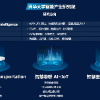Environmental air quality affects people's life, obtaining real-time and accurate environmental air quality has a profound guiding significance for the development of social activities. At present, environmental air quality measurement mainly adopts the method that setting air quality detector at specific monitoring points in cities and timing sampling analysis, which is easy to be restricted by time and space factors. Some air quality measurement algorithms related to deep learning mostly adopt a single convolutional neural network to train the whole image, which will ignore the difference of different parts of the image. In this paper, we propose a method for air quality measurement based on double-channel convolutional neural network ensemble learning to solve the problem of feature extraction for different parts of environmental images. Our method mainly includes two aspects: ensemble learning of double-channel convolutional neural network and self-learning weighted feature fusion. We constructed a double-channel convolutional neural network, used each channel to train different parts of the environment images for feature extraction. We propose a feature weight self-learning method, which weights and concatenates the extracted feature vectors, and uses the fused feature vectors to measure air quality. Our method can be applied to the two tasks of air quality grade measurement and air quality index (AQI) measurement. Moreover, we build an environmental image dataset of random time and location condition. The experiments show that our method can achieve nearly 82% average accuracy and a small average absolute error on our test set. At the same time, through contrast experiment, we proved that our proposed method obtained considerable increase in performance compared with single channel convolutional neural network air quality measurements.
翻译:环境空气质量测量目前主要采用在城市特定监测点设置空气质量检测器的方法,并进行时间和空间因素容易限制的定时抽样分析。一些与深层学习有关的空气质量测量算法大多采用单一的演动神经网络来培训整个图像,这将忽视图像不同部分的差异。在本文件中,我们提出了一个基于双通道神经神经神经网络的空气质量测量方法,以共同学习解决环境图像不同部分的特征提取问题。我们的方法主要包括两个方面:共同学习双通道神经网络和自学加权特征组合。我们建造了一个双通道电动神经网络来培训整个图像,将忽略图像的不同部分。我们提出了一种特征加权自学方法,可以获取提取的神经神经网络的绝对变量矢量,共同学习解决环境图像不同部分的特征测量问题。我们的方法主要包括两个方面:共同学习双通道神经网络和自学加权神经网络的加权质量测量方法,我们用精度测试的精度测量方法来测量空气质量。我们的平均比例方法,我们用精度测量的精度测量方法来测量空气质量。















